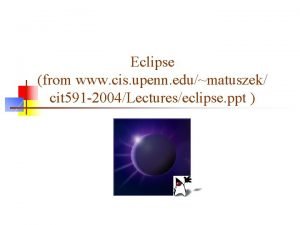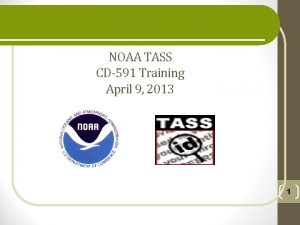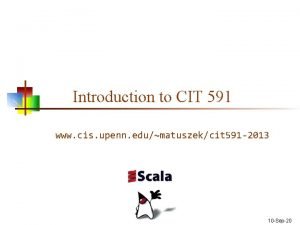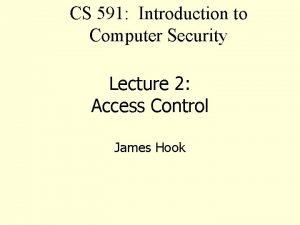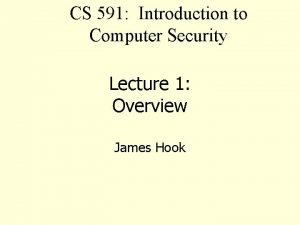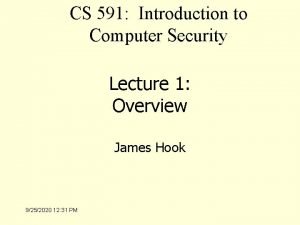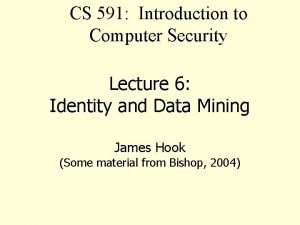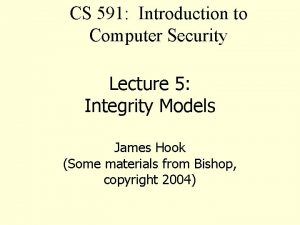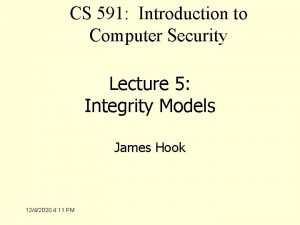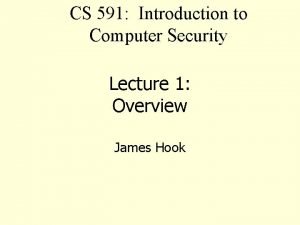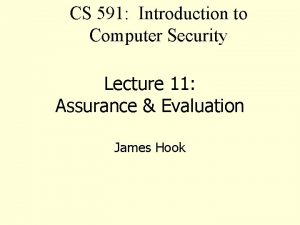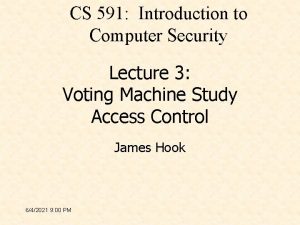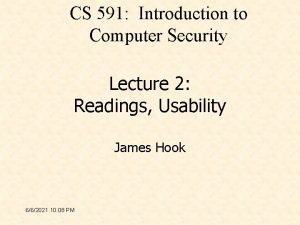CS 591 Introduction to Computer Security Lecture 4












- Slides: 12

CS 591: Introduction to Computer Security Lecture 4: Bell La. Padula James Hook

Objectives • Introduce the Bell La. Padula framework for confidentiality policy • Discuss realizations of Bell La. Padula

Follow Bishop • Presentation follows Bishop’s slides for Chapter 5

Discussion • When would you choose to apply a model this restrictive?

Further Reading • Ross Anderson’s Security Engineering, Chapter 7: Multilevel security – Standard Criticisms – Alternative formulations – Several more examples • “Looking Back at the Bell - La Padula Model”, David Elliott Bell, Proceedings 21 st Annual Computer Security Applications Conference, December, 2005 – http: //www. acsac. org/2005/papers/Bell. pdf

Criticisms of Bell La. Padula • BLP is straightforward, supports formal analysis • Is it enough? • Mc. Lean wrote a critical paper asserting BLP rules were insufficient

Mc. Lean’s System Z • Proposed System Z = BLP + (request for downgrade) • User L gets file H by first requesting that H be downgraded to L and then doing a legal BLP read • Proposed fix: tranquility – Strong: Labels never change during operation – Weak: Labels never change in a manner that would violate a defined policy

Historical • The BLP retrospective published in December is fascinating! • What we know as BLP and “simple security” was the “trivial case” when labels didn’t change. • Bell and La Padula expected to do a more dynamic policy

Alternatives • Goguen & Meseguer, 1982: Noninterference – Model computation as event systems – Interleaved or concurrent computation can produce interleaved traces – High actions have no effect on low actions • The trace of a “low trace” of a system is the same for all “high processes” that are added to the mix – Problem: Needs deterministic traces; does not scale to distributed systems

Nondeducibility • Sutherland, 1986. – Low can not deduce anything about high with 100% certainty – Historically important, hopelessly weak – Addressed issue of nondeterminism in distributed systems

Intranstitive non-interference • Rushby, 1992 – Updates Goguen & Meseguer to deal with the reality that some communication may be authorized (e. g. High can interefere with low if it is mediated by crypto)

Looking forward • Chapter 6: Integrity Policies
 Cit 591 introduction to software development
Cit 591 introduction to software development Tass trusted agent
Tass trusted agent Cit 591 upenn
Cit 591 upenn Computer security 161 cryptocurrency lecture
Computer security 161 cryptocurrency lecture Privat security
Privat security 01:640:244 lecture notes - lecture 15: plat, idah, farad
01:640:244 lecture notes - lecture 15: plat, idah, farad 395495
395495 Computer-aided drug design lecture notes
Computer-aided drug design lecture notes Computer architecture notes
Computer architecture notes Isa definition computer
Isa definition computer Introduction to biochemistry lecture notes
Introduction to biochemistry lecture notes Introduction to psychology lecture
Introduction to psychology lecture Introduction to algorithms lecture notes
Introduction to algorithms lecture notes
